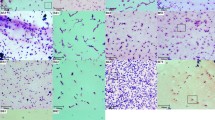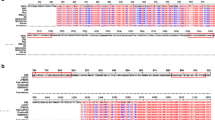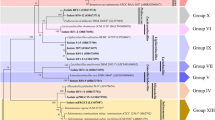Abstracts
Several kinds of carbohydrates such as sorbose, adonitol, and melezitose were found to enhance equol production from daidzein in an in vitro human fecal culture. Sorbose, one of the most effective carbohydrates, was used as a carbohydrate source for isolating the NATTS strain, which was a Gram-positive, non-spore-forming rod bacterium with high ability to convert daidzein to equol isolated from the 7th maintenance culture. The strain was found to belong to the genus Slackia family Coriobacteriaceae by 16S rRNA sequence-based analysis, and the prevalence of the Slackia sp. in Japanese adults was examined by reverse transcription-quantitative PCR (RT-qPCR), which was found to be 40% at a mean population level of 106 cells per gram of feces.




Similar content being viewed by others
References
Akaza H et al (2002) Is daidzein non-metabolizer a high risk for prostate cancer? A case-controlled study of serum soybean isoflavone concentration. Jpn J Clin Oncol 32:296–300
Appt SE (2004) Usefulness of the monkey model to investigate the role soy in postmenopausal women’s health. Ilar J 45:200–211
Arai Y et al (2000) Comparison of isoflavones among dietary intake, plasma concentration and urinary excretion for accurate estimation of phytoestrogen intake. J Epidemiol 10:127–135
Chang YC, Nair MG (1995) Metabolism of daidzein and genistein by intestinal bacteria. J Nat Prod 58:1892–1896
Cole JR et al (2003) The Ribosomal Database Project (RDP-II): previewing a new autoaligner that allows regular updates and the new prokaryotic taxonomy. Nucleic Acids Res 31:442–443
Day AJ et al (2000) Dietary flavonoid and isoflavone glycosides are hydrolysed by the lactase site of lactase phlorizin hydrolase. FEBS Lett 468:166–170
Decroos K, Vanhemmens S, Cattoir S, Boon N, Verstraete W (2005) Isolation and characterisation of an equol-producing mixed microbial culture from a human faecal sample and its activity under gastrointestinal conditions. Arch Microbiol 183:45–55
Fujimoto K et al (2008) Age-stratified serum levels of isoflavones and proportion of equol producers in Japanese and Korean healthy men. Prostate Cancer Prostatic Dis 11:252–257
Hur HG, Lay JO Jr, Beger RD, Freeman JP, Rafii F (2000) Isolation of human intestinal bacteria metabolizing the natural isoflavone glycosides daidzin and genistin. Arch Microbiol 174:422–428
Hur HG et al (2002) Isolation of an anaerobic intestinal bacterium capable of cleaving the C-ring of the isoflavonoid daidzein. Arch Microbiol 178:8–12
Ishiwata N, Melby MK, Mizuno S, Watanabe S (2009) New equol supplement for relieving menopausal symptoms: randomized, placebo-controlled trial of Japanese women. Menopause 16:141–148
Jackman KA, Woodman OL, Sobey CG (2007) Isoflavones, equol and cardiovascular disease: pharmacological and therapeutic insights. Curr Med Chem 14:2824–2830
Jansen GJ, Wildeboer-Veloo AC, Tonk RH, Franks AH, Welling GW (1999) Development and validation of an automated, microscopy-based method for enumeration of groups of intestinal bacteria. J Microbiol Methods 37:215–221
Johnson JL (1994) Similarity analysis of rRNAs. In: Gerhardt P, Murray RG, Wood WA, Krieg NR (eds) Methods for general and molecular bacteriology. American Society for Microbiology, Washington, D.C., pp 683–700
Kelly GE, Joannou GE, Reeder AY, Nelson C, Waring MA (1995) The variable metabolic response to dietary isoflavones in humans. Proc Soc Exp Biol Med 208:40–43
Lukaczer D et al (2005) Clinical effects of a proprietary combination isoflavone nutritional supplement in menopausal women: a pilot trial. Altern Ther Health Med 11:60–65
Lund TD, Munson DJ, Haldy ME, Setchell KDR, Lephart ED, Handa RJ (2004) Equol is a novel anti-androgen that inhibits prostate growth and hormone feedback. Biol Reprod 70:1188–1195
Maruo T, Sakamoto M, Ito C, Toda T, Benno Y (2008) Adlercreutzia equolifaciens gen. nov., sp. nov., an equol-producing bacterium isolated from human faeces, and emended description of the genus Eggerthella. Int J Syst Evol Microbiol 58:1221–1227
Matsuda K, Tsuji H, Asahara T, Kado Y, Nomoto K (2007) Sensitive quantitative detection of commensal bacteria by rRNA-targeted reverse transcription-PCR. Appl Environ Microbiol 73:32–39
Matsuda K, Tsuji H, Asahara T, Matsumoto K, Takada T, Nomoto K (2009) Establishment of an analytical system for the human fecal microbiota, based on reverse transcription-quantitative PCR targeting of multicopy rRNA molecules. Appl Environ Microbiol 75:1961–1969
Matthies A et al (2008) Conversion of daidzein and genistein by an anaerobic bacterium newly isolated from the mouse intestine. Appl Environ Microbiol 74:4847–4852
Matthies A, Blaut M, Braune A (2009) Isolation of a human intestinal bacterium capable of daidzein and genistein conversion. Appl Environ Microbiol 75:1740–1744
Minamida K et al (2006) Production of equol from daidzein by gram-positive rod-shaped bacterium isolated from rat intestine. J Biosci Bioeng 102:247–250
Minamida K et al (2008) Asaccharobacter celatus gen. nov., sp. nov., isolated from rat caecum. Int J Syst Evol Microbiol 58:1238–1240
Mizunuma H, Kanazawa K, Ogura S, Otsuka S, Nagai H (2002) Anticarcinogenic effects of isoflavones may be mediated by genistein in mouse mammary tumor virus-induced breast cancer. Oncology 62:78–84
Morito K et al (2001) Interaction of phytoestrogens with estrogen receptors alpha and beta. Biol Pharm Bull 24:351–356
Morton MS, Arisaka O, Miyake N, Morgan LD, Evans BA (2002) Phytoestrogen concentrations in serum from Japanese men and women over forty years of age. J Nutr 132:3168–3171
Raschke M, Wahala K, Pool-Zobel BL (2006) Reduced isoflavone metabolites formed by the human gut microflora suppress growth but do not affect DNA integrity of human prostate cancer cells. Br J Nutr 96:426–434
Saitou N, Nei M (1987) The neighbor-joining method: a new method for reconstructing phylogenetic trees. Mol Biol Evol 4:406–425
Sathyamoorthy N, Wang TT (1997) Differential effects of dietary phyto-oestrogens daidzein and equol on human breast cancer MCF-7 cells. Eur J Cancer 33:2384–2389
Schoefer L, Mohan R, Braune A, Birringer M, Blaut M (2002) Anaerobic C-ring cleavage of genistein and daidzein by Eubacterium ramulus. FEMS Microbiol Lett 208:197–202
Setchell KD et al (2002) Evidence for lack of absorption of soy isoflavone glycosides in humans, supporting the crucial role of intestinal metabolism for bioavailability. Am J Clin Nutr 76:447–453
Setchell KD et al (2003) Comparing the pharmacokinetics of daidzein and genistein with the use of 13C-labeled tracers in premenopausal women. Am J Clin Nutr 77:411–419
Setchell KD et al (2005) S-equol, a potent ligand for estrogen receptor beta, is the exclusive enantiomeric form of the soy isoflavone metabolite produced by human intestinal bacterial flora. Am J Clin Nutr 81:1072–1079
Thompson JD, Higgins DG, Gibson TJ (1994) CLUSTAL W: improving the sensitivity of progressive multiple sequence alignment through sequence weighting, position-specific gap penalties and weight matrix choice. Nucleic Acids Res 22:4673–4680
Wang XL, Hur HG, Lee JH, Kim KT, Kim SI (2005a) Enantioselective synthesis of S-equol from dihydrodaidzein by a newly isolated anaerobic human intestinal bacterium. Appl Environ Microbiol 71:214–219
Wang XL, Shin KH, Hur HG, Kim SI (2005b) Enhanced biosynthesis of dihydrodaidzein and dihydrogenistein by a newly isolated bovine rumen anaerobic bacterium. J Biotechnol 115:261–269
Watanabe S, Terashima K, Sato Y, Arai S, Eboshida A (2000) Effects of isoflavone supplement on healthy women. Biofactors 12:233–241
Yu ZT, Yao W, Zhu WY (2008) Isolation and identification of equol-producing bacterial strains from cultures of pig faeces. FEMS Microbiol Lett 282:73–80
Zafar TA, Weaver CM, Jones K, Moore DR II, Barnes S (2004) Inulin effects on bioavailability of soy isoflavones and their calcium absorption enhancing ability. J Agric Food Chem 52:2827–2831
Acknowledgments
We thank Kazunori Matsuda, Toshihisa Ohta, Takuya Takahashi, Mitsuyoshi Kano, Masami Morotomi, and Shigeyoshi Sakamoto for their helpful discussion.
Author information
Authors and Affiliations
Corresponding author
Additional information
Communicated by Erko Stackebrandt.
Rights and permissions
About this article
Cite this article
Tsuji, H., Moriyama, K., Nomoto, K. et al. Isolation and characterization of the equol-producing bacterium Slackia sp. strain NATTS. Arch Microbiol 192, 279–287 (2010). https://doi.org/10.1007/s00203-010-0546-z
Received:
Accepted:
Published:
Issue Date:
DOI: https://doi.org/10.1007/s00203-010-0546-z




